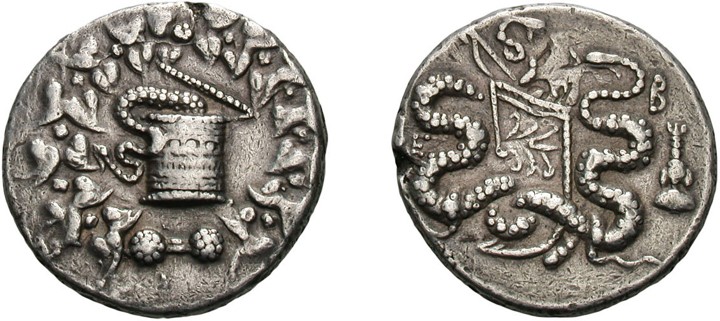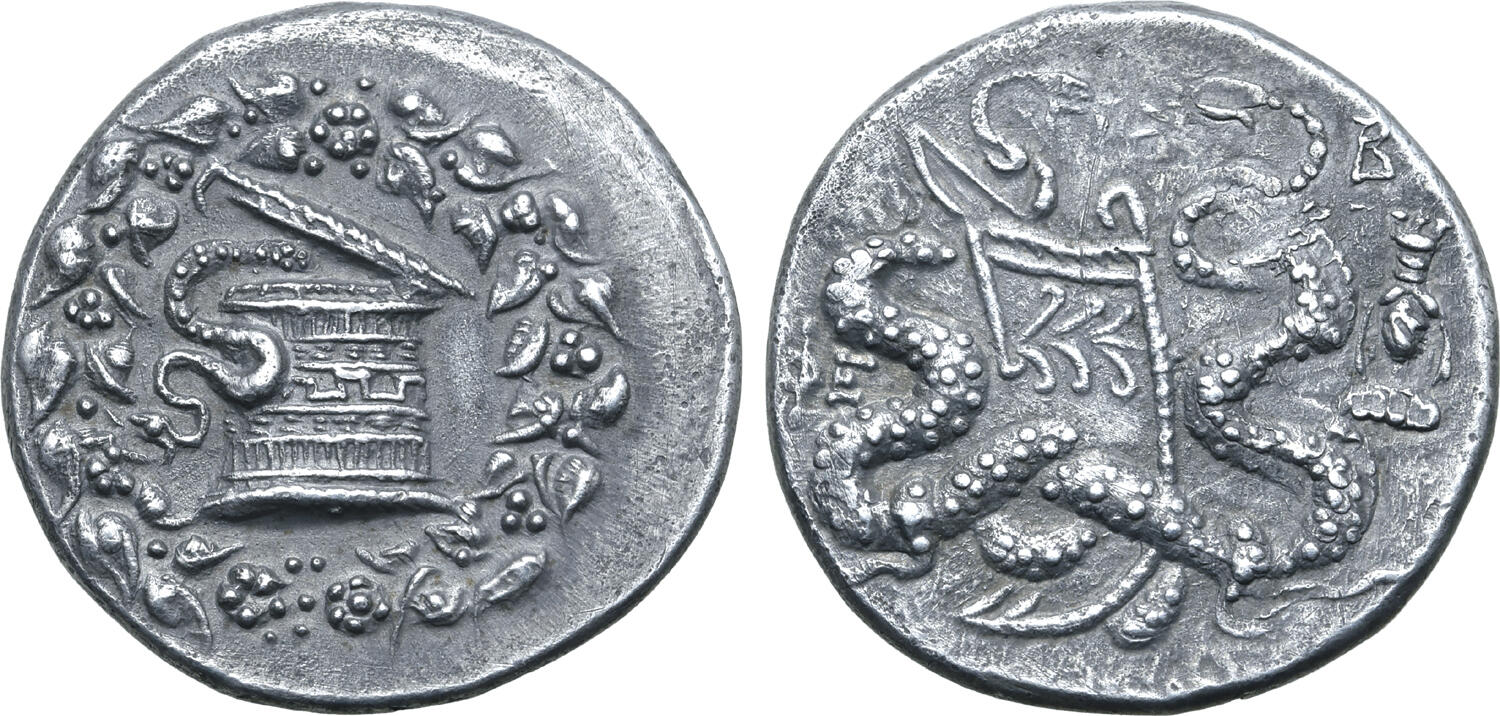19062 - Ephesus (cistophoric tetradrachm) over cistophoric tetradrachm (Berk, BBS 181, Nov. 2012, 335)
From SILVER
138 BCE - 137 BCE | ΕΦΕ
Images
Overstriking coin

Ephesus_2530_Berk.jpg [1]
Location/history
| Sale(s)Sale(s) ᵖ: | Berk, BBS 181, 7 Nov. 2012, 335 | |
Overstriking coin
Description
| ObverseInscription or printing placed on the obverse.: | Cista mystica with half-open lid, from which a snake issues to left, all within ivy wreath. | ReverseInscription or printing placed on the reverse.: | ΕΦΕ (Greek) Two snakes surrounding an ornamented bow case, strap right, containing strung bow. date B=2 and facing bust of Artemis Ephesia with lofty headdress |
Mint and issuing power
| MintIdentifies the place of manufacture or issue of a numismatic object.: | Ephesus | Ancient regionAncient region. | Ionia | Modern countryModern country: Turkey | AuthorityIdentifies the issuing power. The authority can be "pretended" when the name or the portrait of X is on the coin but he/she was not the issuing power. It can also be "uncertain" when there is no mention of X on the coin but he/she was the issuing power according to the historical sources: | Attalid Kingdom |
Chronology
| FromIdentifies the initial date in a range assigned in a numismatic context. 138 BCE toIdentifies the final date in a range assigned in a numismatic context.. 137 BCE | Hellenistic 323-30 BC |
Physical description
| MetalThe physical material (usually metal) from which an object is made.: Silver |
WeightWeight of the numismatic object (in grams). in grams: 12.6412.64 g <br />12,640 mg <br /> | DenominationTerm indicating the value of a numismatic object. Examples: tetradrachm, chalkous, denarius.: cistophoric tetradrachm | |
| StandardStandard.: Cistophoric | |||
References
| Coin referenceReference of the Coin: | Coin series referenceReference to coin series study: | Kleiner - Noe 19771Kleiner - Noe 1977, Series 36, 51, pl. XVI.11 (same obv. die), Carbone 20202Carbone 2020 |
Overstruck type
Description
| ObverseInscription or printing placed on the obverse.: | Cista mystica with half-open lid, from which a snake issues to left, all within ivy wreath. | ReverseInscription or printing placed on the reverse.: | (Greek) Two snakes surrounding an ornamented bow case, strap right, containing strung bow |
Mint and issuing power
| MintIdentifies the place of manufacture or issue of a numismatic object. ᵖ: | Ancient regionAncient region. ᵖ | Ionia | Modern countryModern country: | AuthorityIdentifies the authority in whose name (explicitly or implicitly) a numismatic object was issued. ᵖ: | Attalid Kingdom |
Chronology
| FromIdentifies the initial date in a range assigned in a numismatic context. 140 BCE toIdentifies the final date in a range assigned in a numismatic context.. 137 BCE | Hellenistic 323-30 BC |
Physical description
| DenominationTerm indicating the value of a numismatic object. Examples: tetradrachm, chalkous, denarius. ᵖ: | cistophoric tetradrachm | StandardStandard. ᵖ: | Cistophoric |
References
| Coin type referenceReference to coin series study ᵖ: |
Additional data
| Frequency of overstrikesFrequency of overstrikes: | rare and concentrated | Level of confidenceLevel of confidence of the identification: | sure |
| RemarksRemarks: | "Possibly overstruck: traces of undertype (?) above the bowcase on reverse" (nb: on another cistophoric tetradrachm - typical pattern of the upper r. summit of the gorytus (two lines) and the departure of the bow; this pattern is typical only for cistophoric tetradrachms struck at Ephesus at the same moment...) | ||
